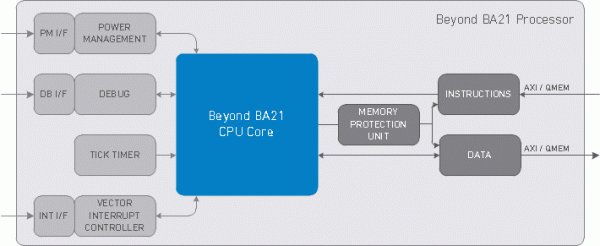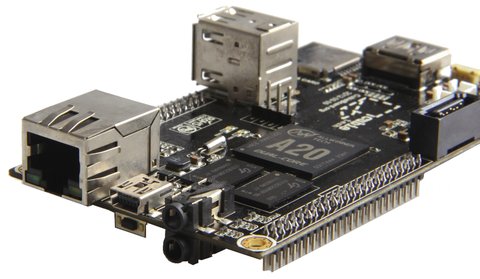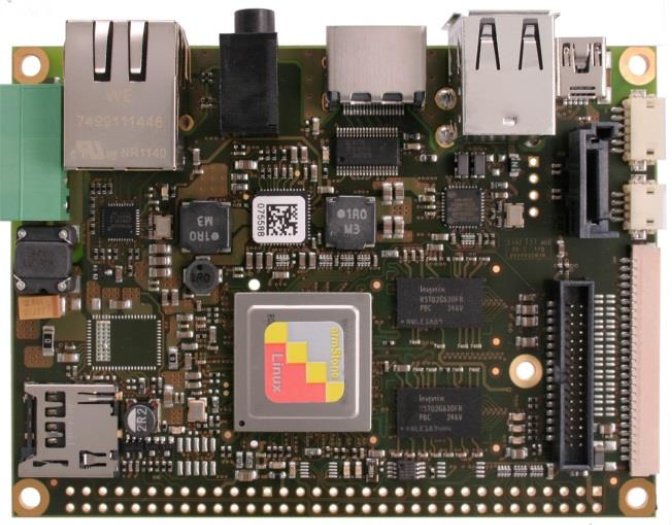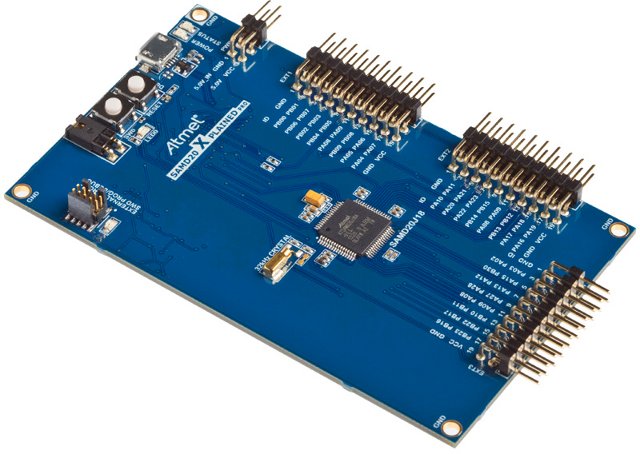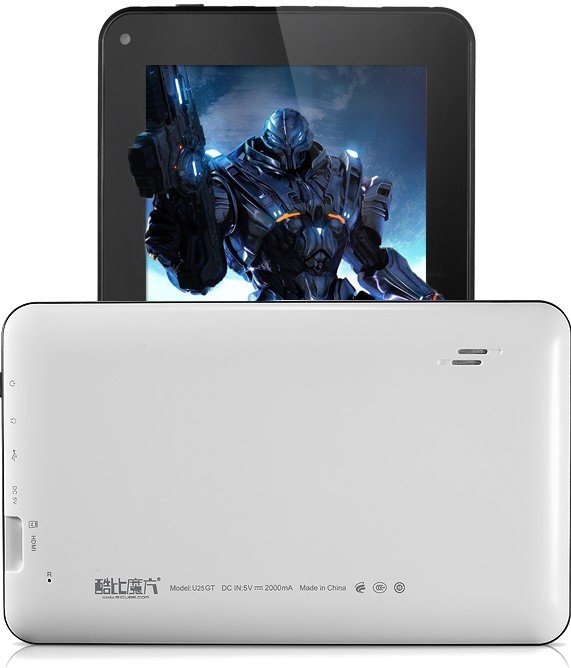Beyond Semiconductor, a Ljubljana, Slovenia based company, has recently announced BA21, a 32-bit processor core, with 2.5 Coremark per megahertz, and clocked up to 125 MHz, that’s roughly equivalent to a Cortex M3 core @ 120 MHz. Target applications include mixed signal embedded processing, wireless communications ICs (e.g. Bluetooth, Zigbee, GPS), industrial Microcontrollers, and battery-powered or ultra-low-cost devices.If you’ve never heard about Beyond Semi, you may want to read my previous article about their BA25 core (Cortex A7/A8 equivalent) for a bit more details about the company. Here are the key features of BA21 core: 32-bit Processor Small silicon footprint (less than 10k gates) for lower leakage and dynamic CPU power Two-stage pipeline architecture Extreme Code Density for lower instruction fetching energy Advanced power management Dynamic clock gating and power shut-off of unused units Software- and hardware-controlled clock frequency Wake-up on tick timer or external interrupt Performance Up to 2.5 […]
Cubieboard2 Powered By AllWinner A20 is now Available for $59
Cubieboard is a low cost board based on AllWinner A10 with lots of ports and expansion pins, that supports Linux and Android. There’s now a new version called Cubieboard2 based on the same board but powered by AllWinner A20 dual core Cortex A7 processor instead, and still with 1GB RAM and 4GB Flash. As you can see the specifications are the same as the original Cubieboard except for the SoC: SoC – AllWinner A20 Dual core ARM Cortex-A7 processor with Mali-400 MP2 GPU System Memory – 1GB DDR3 Storage – 4GB internal NAND flash, up to 64GB on micro SD slot, and up to 2TB on 2.5″ SATA disk Video Output – HDMI Connectivity – 10/100M Ethernet, plus optional Wi-Fi module USB – 2x USB 2.0 HOST, 1x USB 2.0 OTG Expansion headers – 96 pins including I2C, SPI, RGB/LVDS, CSI/TS, FM-IN, ADC, CVBS, VGA, SPDIF-OUT, R-TP, and more Misc […]
F&S armStoneA9 is a Pico-ITX Board Powered by Freescale i.MX 6 with up to 4GB RAM
F&S Elektronik Systeme GmbH has announced the armstoneA9, a pico-ITX board featuring Freescale i.MX 6 Solo/Dual or Quad Cortex A9 processor with up to 4GB DDR3 SDRAM, and 128 MB flash (1GB+ flash optional) that available in both commercial and industrial temperature range. Here are the specifications of the board: SoC – Freescale i.MX 6 Cortex-A9 (Quad-/ Dual-/ Single-Core) @ 800 MHz to 1 GHz with Vivante GPU System Memory – 1GB (standard version) to 4 GB DDR3 SDRAM Storage – 128MB Flash (1GB+ optional), micro-SD Card Slot, and SATA interface Display: up to SVGA (800 x 600, 65536 colors) via RGB up to WUXGA (1920 x 1200, 18Bit/ 24Bit) via 2x LVDS up to FullHD (1920 x 1080, 24Bit) via HDMI Touch Panel – 4-wire, analogue resistive and PCAP-Touch Interface via I2C Interfaces: 1x 10/100/1000MBit Ethernet 3x Serial (2x RS232, 1x TTL 3.3V Level) 1x USB 2.0 Host, 1x […]
Atmel SAM D20 MCU Family Features ARM Cortex M0+ Core
Atmel has just announced its SAM D20 family of embedded Flash micro-controllers based on ARM Cortex-M0+ processor core, designed for low power applications such as home automation, consumer, smart metering and industrial applications. The key features of Atmel SAM D20 MCUs are as follows: Cortex M0+ @ 48MHz, 2.14 Coremark/MHz Single-cycle IO access, supporting a pin toggling frequency up to 24 MHz Eight-channel event system Peripherals: Four to six serial communication modules (SERCOM) configurable as UART/USART, SPI or I2C Up to eight 16-bit Timer/Counters Peripheral touch controller (PTC) that supports up to 256 channels and supports buttons, sliders, wheels, and proximity Real Time Clock (RTC) and calendar with leap year correction 12-bit 350ksps ADC and 10-bit DAC Power Consumption: <150µA/MHz <2µA RAM retention and RTC Options between internal and external oscillators and on-the-fly clock switching The family supports features 14 new devices available in 32-, 48- and 64-pin package options […]
Rockchip RK3168 Powered Tablets Are Starting to Show Up for Sale
Rockchip first showcased a tablet prototype with RK3168 dual core processor at the Hong Kong Electronics Fair in April, showing lower power consumption compared to RK3066. At the time, tablets based on this processor were still in development, but this has changed as a few RK3168 tablets are now showing up in Aliexpress. Prices for 7″ Android tablets such as Cube U25GT PRO, are now about $110 as low as $75 including shipping, but this should come down as more sellers provide the devices. Cube U25GT PRO is an updated version of the U25GT pictured above. Here are the specifications of the PRO version: SoC – Rockchip RK3168 @ 1.2 GHz with PowerVR SGX540 GPU System Memory – 512 MB RAM Storage – 8GB NAND Flash + micro SD card slot Display – 7″ 5 point touch capacitive screen (1024×600) Camera – 0.3MP front camera Connectivity – Wifi 802.11b/g/n + […]
iPazzPort SY-20-19VC Android STB is also a Remote Control Charging Dock
iPazzPort SY-20-19VC, aka iPazzPort Pearl, is an Android 4.1.1 set-top box powered by Rockchip RK3066 that comes bundled with with a dual sided RF remote with a QWERTY keyboard, touch pad, and voice support. That’s pretty common these days. The design however, is somewhat original, as once you’re done watching videos or playing games, you can put back the remote into an opening in the set-top box to store it and recharge it, and it may prevent you from losing the remote under the pillows, and the remote will be fully charged most of the time. Here are the specifications of this media player: SoC – Rockchip RK3066 @ 1.6GHz + Mali-400 MP4 GPU System Memory – 1GB DDR3 Storage – 4GB + micro SD card slot (up to 32GB, or is it 16GB?) Connectivity 802.11b/g/n Wi-Fi 10/100M Ethernet 3G via external USB 3G dongle Video Output – HDMI 1.4 […]
Stealth Nighthawk F-117A is a Raspberry Pi-in-a-Stick Preloaded with XBMC
Stealth Nighthawk F-117A was a “single-seat, twin-engine stealth ground-attack aircraft formerly operated by the United States Air Force (USAF)”, but it’s now an HDMI dongle based on the same processor as the Raspberry Pi, namely Broadcom BCM2825, software compatible with the Raspberry Pi, and preloaded with an XBMC OS, which turns out to the Raspbmc. The main hardware differences with Raspberry Pi are that you lose Ethernet, composite output, and all headers used for hardware hacking, but you gain Wi-Fi, a casing, and an even smaller form factor. Here are the specifications of the device: SOC – Broadcom BCM2835 @ 700mhz with Video Core IV GPU/VPU System Memory – 512MB Storage – micro SD card slot (up to 32GB) USB – 1x USB 2.0 host port + micro USB port for power Video Output – HDMI (up to 1080p) Connectivity – Wi-Fi 802.11n Power – 5V/1A via microUSB port Dimensions – […]
This is How the BeagleBone Black is Manufactured
CircuitCo has recently uploaded an interesting “Make of the BeagleBone Black” video showing how the BeagleBone Black is manufactured in their facilities in Richardson, Texas, USA. The main steps are as follows: A machine applies solder paste to the PCB Pick and place components Reflow soldering for SMT components Hand placement of through hole components such as the Ethernet connector Selective soldering PCB washing Optical inspection via an automatic optical inspection (AOI) machine Manual inspection Burn-in tests after flashing the board with factory firmware Functional testing Packing and shipping Beside the overall process, one interesting point is that human hands are only involved with through-hole components placement, functional testing and packing & shipping. Even those steps may eventually be automatized in the future with robots such as Baxter. Watch the video, it’s worth a look. Jean-Luc Aufranc (CNXSoft)Jean-Luc started CNX Software in 2010 as a part-time endeavor, before quitting his […]


